SNOSB47E May 2011 – August 2016 LMH6521
PRODUCTION DATA.
- 1 Features
- 2 Applications
- 3 Description
- 4 Revision History
- 5 Pin Configuration and Functions
- 6 Specifications
- 7 Detailed Description
- 8 Application and Implementation
- 9 Power Supply Recommendations
- 10Layout
- 11Device and Documentation Support
- 12Mechanical, Packaging, and Orderable Information
Package Options
Mechanical Data (Package|Pins)
- RTV|32
Thermal pad, mechanical data (Package|Pins)
- RTV|32
Orderable Information
6 Specifications
6.1 Absolute Maximum Ratings
over operating free-air temperature range (unless otherwise noted)(1)(2)| MIN | MAX | UNIT | ||
|---|---|---|---|---|
| Positive supply voltage (pin 14 and 27) | –0.6 | 5.5 | V | |
| Differential voltage between any two grounds | < 200 | mV | ||
| Analog input voltage | –0.6 | V+ | V | |
| Digital input voltage | –0.6 | 5.5 | V | |
| Soldering temperature, infrared or convection (30 s) | 260 | °C | ||
| Junction temperature, TJ | 150 | °C | ||
| Storage temperature, Tstg | –65 | 150 | °C | |
(1) Stresses beyond those listed under Absolute Maximum Ratings may cause permanent damage to the device. These are stress ratings only, which do not imply functional operation of the device at these or any other conditions beyond those indicated under Recommended Operating Conditions. Exposure to absolute-maximum-rated conditions for extended periods may affect device reliability.
(2) If Military/Aerospace specified devices are required, please contact the Texas Instruments Sales Office/ Distributors for availability and specifications.
6.2 ESD Ratings
| VALUE | UNIT | |||
|---|---|---|---|---|
| V(ESD) | Electrostatic discharge | Human-body model (HBM)(1)(2) | ±2000 | V |
| Charged-device model (CDM)(3) | ±750 | |||
| Machine model (MM) | ±200 | |||
(1) JEDEC document JEP155 states that 500-V HBM allows safe manufacturing with a standard ESD control process.
(2) Human-body model, applicable std. MIL-STD-883, Method 3015.7. Field-induced Charge-device model, applicable std. JESD22-C101-C (ESD FICDM std. of JEDEC). Machine model, applicable std. JESD22-A115-A (ESD MM std. of JEDEC).
(3) JEDEC document JEP157 states that 250-V CDM allows safe manufacturing with a standard ESD control process.
6.3 Recommended Operating Conditions
over operating free-air temperature range (unless otherwise noted)(1)| MIN | MAX | UNIT | ||
|---|---|---|---|---|
| Supply voltage (pin 14 and 27) | 4.75 | 5.25 | V | |
| Differential voltage between any two grounds | <10 | mV | ||
| Analog input voltage, AC coupled | 0 | V+ | V | |
| TA | Ambient temperature(2) | –40 | 85 | °C |
(1) Absolute Maximum Ratings indicate limits beyond which damage to the device may occur. Recommended Operating Ratings indicate conditions for which the device is intended to be functional, but specific performance is not ensured. For ensured specifications, see Electrical Characteristics.
(2) The maximum power dissipation is a function of TJ(MAX), RθJA. The maximum allowable power dissipation at any ambient temperature is PD = (TJ(MAX) – TA) / RθJA. All numbers apply for packages soldered directly onto a PCB.
6.4 Thermal Information
| THERMAL METRIC(1) | LMH6521 | UNIT | |
|---|---|---|---|
| RTV (WQFN) | |||
| 32 PINS | |||
| RθJA | Junction-to-ambient thermal resistance | 45 | °C/W |
| RθJC(top) | Junction-to-case (top) thermal resistance | 23.7 | °C/W |
| RθJB | Junction-to-board thermal resistance | 9.1 | °C/W |
| ψJT | Junction-to-top characterization parameter | 0.3 | °C/W |
| ψJB | Junction-to-board characterization parameter | 9.1 | °C/W |
| RθJC(bot) | Junction-to-case (bottom) thermal resistance | 3.6 | °C/W |
(1) For more information about traditional and new thermal metrics, see the Semiconductor and IC Package Thermal Metrics application report.
6.5 Electrical Characteristics
The following specifications apply for single supply with V+ = 5 V, differential VOUT = 4 VPP, RL= 200 Ω, TA = 25°C,fin = 200 MHz, and maximum gain (0 attenuation)(1)
| PARAMETER | TEST CONDITIONS | MIN(2) | TYP(3) | MAX(2) | UNIT | ||
|---|---|---|---|---|---|---|---|
| DYNAMIC PERFORMANCE | |||||||
| SSBW | 3-dB small signal bandwidth | 1200 | MHz | ||||
| Output noise voltage | Amplifier output with RSOURCE = 200 Ω | 33 | nV/√Hz | ||||
| Noise figure | Source = 200 Ω | 7.3 | dB | ||||
| OIP3 | Output 3rd-order intercept point | f = 100 MHz, PO= 4 dBm per tone | 56 | dBm | |||
| f = 200 MHz, PO= 4 dBm per tone | 48.5 | ||||||
| f = 250 MHz, PO= 4 dBm per tone | 46.5 | ||||||
| OIP2 | Output 2nd-order intercept point | f = 100 MHz, PO= 4 dBm per tone | 92 | dBm | |||
| f = 200 MHz, PO= 4 dBm per tone | 80 | ||||||
| f = 250 MHz, PO= 4 dBm per tone | 73 | ||||||
| HD2 | 2nd harmonic distortion | f = 200 MHz, PO= 6 dBm | –84 | dBc | |||
| HD3 | 3rd harmonic distortion | f = 200 MHz, PO= 6 dBm | –83 | dBc | |||
| P1dB | 1-dB compression point | 17 | dBm | ||||
| ANALOG I/O | |||||||
| Input resistance | Differential | 200 | Ω | ||||
| Input common mode voltage | Self biased (AC coupled) | 2.5 | V | ||||
| Input common mode voltage range | Externally driven (DC coupled) | 2 to 3 | V | ||||
| Maximum input voltage swing | Differential | 11 | VPPD | ||||
| Output resistance | Differential | 20 | Ω | ||||
| Maximum differential output voltage swing | Differential | 10 | VPPD | ||||
| CMRR | Common mode rejection ratio | DC, VID = 0 V, VCM = 2.5 V ±0.5 V | 80 | dB | |||
| PSRR | Power supply rejection ratio | DC, V+ = 5 V ±0.5 V, VIN = 2.5 V | 77 | dB | |||
| Channel to channel isolation | f = 200 MHz, minimum attenuation setting | 73 | dB | ||||
| GAIN PARAMETERS | |||||||
| Maximum voltage gain | Gain Code 000000 (min. attenuation), Av = VO / VIN |
26 | dB | ||||
| Minimum voltage gain | Gain Code 111111 (max. attenuation), Av = VO / VIN |
–5.5 | dB | ||||
| Gain accuracy | 1% | ||||||
| Gain step size | 0.5 | dB | |||||
| Channel gain matching | ChA – ChB, any gain setting | ±0.04 | dB | ||||
| Channel phase matching | ChA – ChB, any gain setting | ±0.45 | ° | ||||
| Cumulative gain error | 0 to 12 dB attenuation setting | ±0.1 | dB | ||||
| 0 to 24 dB attenuation setting | ±0.3 | ||||||
| 0 to 31 dB attenuation setting | ±0.5 | ||||||
| Cumulative phase shift | 0 to 12 dB attenuation setting | ±0.6 | ° | ||||
| 0 to 24 dB attenuation setting | ±5.3 | ||||||
| 0 to 31 dB attenuation setting | ±16.5 | ||||||
| Gain step switching time | 15 | ns | |||||
| Gain temperature sensitivity | 0 attenuation setting | 2.7 | mdB/°C | ||||
| POWER REQUIREMENTS | |||||||
| VCC | Supply voltage | 4.75 | 5 | 5.25 | V | ||
| ICC | Supply current | Both channels enabled | TA = –40°C to 85°C | 225 | mA | ||
| TA = –65°C to 150°C | 245 | ||||||
| ICC | Disabled supply current | Both channels | 35 | mA | |||
| ALL DIGITAL INPUTS(4) | |||||||
| VIL | Logic input low voltage | 0.5 | V | ||||
| VIH | Logic input high voltage | 1.8 | V | ||||
| IIH | Logic input high input current | Digital input voltage = 5 V | 200 | µA | |||
| IIL | Logic input low input current | Digital input voltage = 0 V | –60 | µA | |||
(1) Electrical Table values apply only for factory testing conditions at the temperature indicated. No ensurance of parametric performance is indicated in the electrical tables under conditions different than those tested
(2) Limits are 100% production tested at 25°C. Limits over the operating temperature range are ensured through correlation using Statistical Quality Control (SQC) methods.
(3) Typical values represent the most likely parametric norm as determined at the time of characterization. Actual typical values may vary over time and also depends on the application and configuration. The typical values are not tested and are not ensured on shipped production material.
(4) Logic compatibility is TTL, 2.5-V CMOS, and 3.3-V CMOS.
6.6 Timing Requirements
| MIN | NOM | MAX | UNIT | ||
|---|---|---|---|---|---|
| PARALLEL AND PULSE MODE TIMING | |||||
| tGS | Setup time | 3 | ns | ||
| tGH | Hold time | 3 | ns | ||
| tLP | Latch low pulse width | 7 | ns | ||
| tPG | Pulse gap between pulses | 20 | ns | ||
| tPW | Minimum pulse width (pulse mode) | 15 | ns | ||
| tRW | Reset width | 10 | ns | ||
| SERIAL MODE TIMING AND AC CHARACTERISTICS (SPI COMPATIBLE) | |||||
| fSCLK | Max serial clock frequency | 50 | MHz | ||
| tPH | SCLK high state duty cycle | 50% | SCLK | ||
| tPL | SCLK low state duty cycle | 50% | SCLK | ||
| tSU | Serial data in setup time | 2 | ns | ||
| tH | Serial data in hold time | 2 | ns | ||
| tOZD | Serial data out TRI-STATE-to-driven time (referenced to negative edge of SCLK) | 10 | ns | ||
| tOD | Serial data out output delay time (referenced to negative edge of SCLK) | 10 | ns | ||
| tCSS | Serial chip select setup time (referenced to positive edge of SCLK) | 5 | ns | ||
6.7 Typical Characteristics
V+ = 5 V, Differential VOUT = 4 VPP, RL = 200 Ω, TA = 25°C, fin = 200 MHz, and Maximum Gain (0 Attenuation)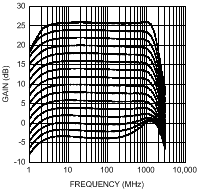 Figure 1. Frequency Response 2-dB Gain Steps
Figure 1. Frequency Response 2-dB Gain Steps
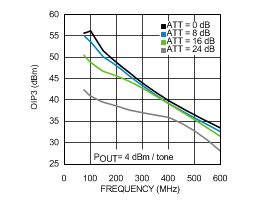 Figure 3. OIP3 vs Frequency
Figure 3. OIP3 vs Frequency
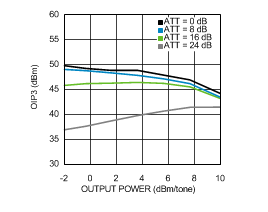 Figure 5. OIP3 vs Pout
Figure 5. OIP3 vs Pout
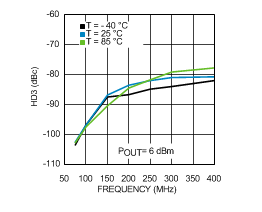 Figure 7. Third Order Harmonic Distortion
Figure 7. Third Order Harmonic Distortionvs Frequency
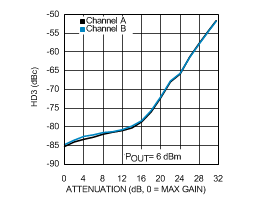 Figure 9. Third Order Harmonic Distortion
Figure 9. Third Order Harmonic Distortionvs Attenuation
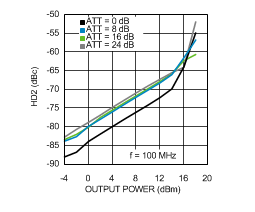 Figure 11. Second Order Harmonic Distortion
Figure 11. Second Order Harmonic Distortionat 100 MHz
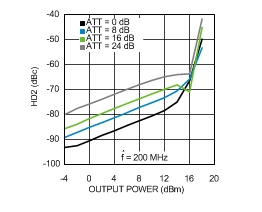 Figure 13. Second Order Harmonic Distortion
Figure 13. Second Order Harmonic Distortionat 200 MHz
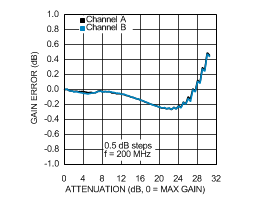 Figure 15. Cumulative Gain Error
Figure 15. Cumulative Gain Error
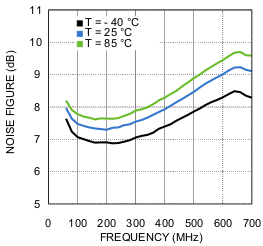 Figure 17. Noise Figure vs Frequency
Figure 17. Noise Figure vs Frequency
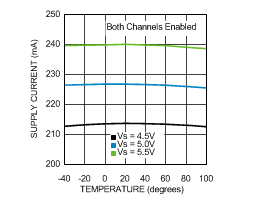 Figure 19. Supply Current vs Temperature
Figure 19. Supply Current vs Temperature
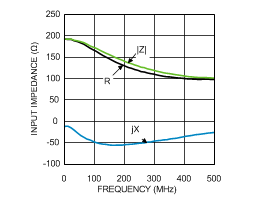 Figure 21. Input Impedance
Figure 21. Input Impedance
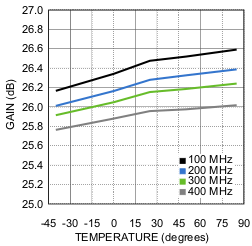 Figure 2. Gain Flatness vs Temperature
Figure 2. Gain Flatness vs Temperature
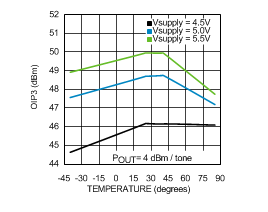 Figure 4. OIP3 vs Temperature
Figure 4. OIP3 vs Temperature
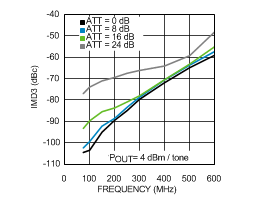 Figure 6. Third Order Intermodulation Products
Figure 6. Third Order Intermodulation Productsvs Frequency
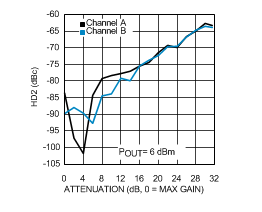 Figure 8. Second Order Harmonic Distortion
Figure 8. Second Order Harmonic Distortionvs Attenuation
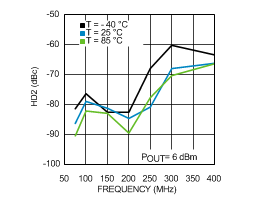 Figure 10. Second Order Harmonic Distortion
Figure 10. Second Order Harmonic Distortionvs Frequency
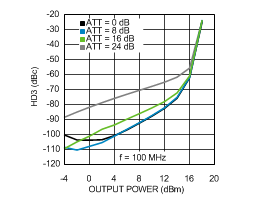 Figure 12. Third Order Harmonic Distortion
Figure 12. Third Order Harmonic Distortionat 100 MHz
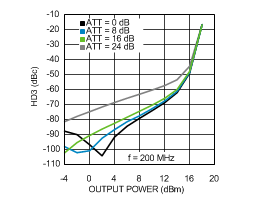 Figure 14. Third Order Harmonic Distortion
Figure 14. Third Order Harmonic Distortionat 200 MHz
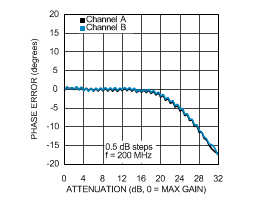 Figure 16. Cumulative Phase Shift
Figure 16. Cumulative Phase Shift
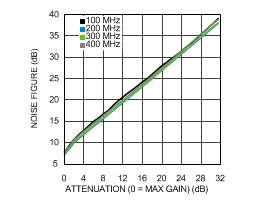 Figure 18. Noise Figure vs Attenuation
Figure 18. Noise Figure vs Attenuation
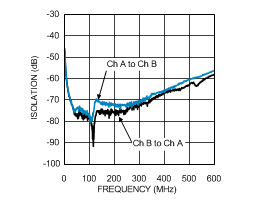 Figure 20. Channel-to-Channel Isolation
Figure 20. Channel-to-Channel Isolation
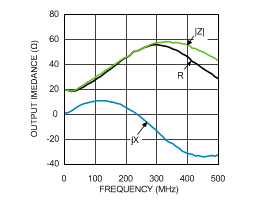 Figure 22. Output Impedance
Figure 22. Output Impedance